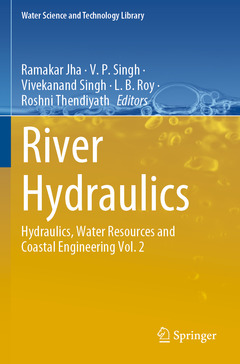Description
River Hydraulics, 1st ed. 2022
Hydraulics, Water Resources and Coastal Engineering Vol. 2
Water Science and Technology Library Series, Vol. 110
Coordinators: Jha Ramakar, Singh V. P., Singh Vivekanand, Roy L. B., Thendiyath Roshni
Language: English
Subjects for River Hydraulics:
Publication date: 12-2022
471 p. · 15.5x23.5 cm · Paperback
Publication date: 12-2021
471 p. · 15.5x23.5 cm · Hardback
Description
/li>Contents
/li>Biography
/li>Comment
/li>
This book presents key principles of the hydraulics of river basins, with a unique focus on the interplay between stream flows and sediment transport. Addressing a number of basic topics related to the hydraulics of river systems, above all it emphasizes applicative aspects in order to provide the reader with a solid grasp of river engineering. The understanding of the river hydraulics is essential for the assessment of optimum locations for the conservation of water resources and its structures.
This book will be interesting to readers and researchers working in the specialized area of river hydraulics of Ganga basin, Narmada, Tapi, Godavari, and other basins of India. It consists of review on hydraulics of meandering river; hydraulic design of reservoir in permeable pavement; optimization of hydraulic design; hydraulic investigations to optimize the design of spillway and design of energy dissipater; and analysis of performance of orifice spillway using computational fluid dynaics
Preface
Introduction from the Editors
Acknowledgements
1 Effect of bed permeability on flow turbulence in gravel-bed stream
Sai Rupesh and Dr.Ratul Das
2 Study on Erosion and Undercut of Cohesive River Bank – An Experimental ApproachVikas Kumar Das, Susanta Chaudhuri and Koustuv Debnath
3 Hydraulic design of reservoir in permeable pavement for mitigating urban storm water
Sanjeev Kumar Suman and Rajnish
4 Analytical expression for measurement of discharge using conical obstruction in a small rectangular channel
Ankur Kapoor, Aniruddha Ghare and Avinash Vasudeo
5 Efficient numerical algorithm for flow field around vertically submerged tandem and aligned circular cylinders
Abhijit Rout, Soni Parth Kaushikbhai and Arindam Sarkar
6 Experimental and Numerical Analysis of Boundary Shear Stress in Non-Prismatic Compound Channel, Laxmikant Das, Kishanjit Kumar Khatua and Bhabani Shankar Das
7 Turbulence flow statistics downstream of grids with various mesh size
Pankaj Raushan, Santosh Singh and Koustuv Debnath
8 Surge analysis of Long piping
S Ghule, P M Abdul Rahiman and K U Farande
9 Review on hydraulics of meandering river
Jyotirmoy Barman, Bimlesh Kumar and Jyotismita Taye
10 Prediction of discharge coefficient for side rectangular weir using group method of data handling (gmdh)
Ali Shariq, Ajmal Hussain and Mujib Ahmad Ansari
11 Enhancement of energy disipation using combination of solid roller bucket and type ii stilling basin for ogee stepped spillwayPrakash Nangare and Alka Kote
12 Estimation of coefficient of discharge for side compound weir using gmdh technique
Mujib Ahmad Ansari, Ajmal Hussain and Faisal Ahmed
13 Flow distributions in compound channel with diverging floodplains
Bhabani Shankar Das, Kamalini Devi, Jnana Ranjan Khuntia and Kishanjit Kumar Khatua14 Boundary shear stress distributions in compound channels having narrowing and enlarging floodplains
Kamalini Devi, Bhabani Shankar Das, Jnana Ranjan Khuntia and Dr. Kishanjit Kumar Khatua
15 Turbulence characteristics in a vegetated open channel under unsteady flow conditionsJnana Ranjan Khuntia, Kamalini Devi, Bhabani Shankar Das and Dr. Kishanjit Kumar Khatua
16 Study of scour near pier of gandhi setu in ganga river
Binit Kumar and Vivekanand Singh
17 Optimization of hydraulic design of URI-II Dam spillway, Jammu and Kashmir
V S Ramarao, M R Bhajantri and V V Bhosekar
18 Modification of spillway SKI jump bucket subjected to higer tail water levels
V S Ramarao, M R Bhajantri, V V Bhosekar and K T More
19 Prediction of submerged vegetated flow in a channel using gmdh-type neural network approach, Nekita Boraah and Bimlesh Kumar20 Turbulence flow statistics over a train of k-type roughness
Santosh Kumar Singh, Pankaj Kumar Raushan and Koustuv Debnath
Conclusion
Ramakar Jha is a chair professor at the Department of Civil Engineering and has 30 years of experience in the field of Hydrology andwater resources engineering. Dr Jha is presently working as Chair Professor in the Department of Civil Engineering, National Institute of Technology (NIT) Patna-INDIA, which is a Premier Institute in India under the Ministry of Human Resource Development, Government of India. Dr. Jha has served at various levels from Scientist-B to Scientist-E1 at National Institute of Hydrology (NIH), Roorkee, India and as Professor in the Department of Civil Engineering, NIT Rourkela. He has worked and working as Country Co-ordinator of UNESCO- GWADI and Principal Investigator for many International (EU-FP7, DAAD, ADB, AUS-Aid) and National research and consultancy projects (ISRO, DST, MoWR, MHRD). Moreover, he served as Chair for many administrative positions and received a coupel of international and national awards for research papers. Presently, he is working as Dr Rajendra Prasad Chair for Water resources under the Ministry of Water Resources, Government of India in the Department of Civil Engineering, NIT Patna, Bihar.
V. P. Singh A Texas A&M professor of Indian origin is receiving a prestigious award for his world-renowned work on water. Vijay P. Singh is receiving the 2013 Lifetime Achievement Award from the American Society of Civil Engineers-Environmental and Water Resources Institute, otherwise known as the ASCE-EWRI. The award is in recognition of Singh’s work in the field of hydrology, which is the study of water in all aspects, such as quality, distribution, preservation, transportation, etc. Some of the work he has done has even created an entire new branch of hydrology – called entropic hydrology – that is connected to the study of entropy, which means essentially the study of order and disorder as it relates to the physical universe. His work is considered fundamental for flood planning and water modelin
Offers key principles of river basin hydraulics
Presents a review on the hydraulics of a meandering river
Provides insights into understanding river engineering




